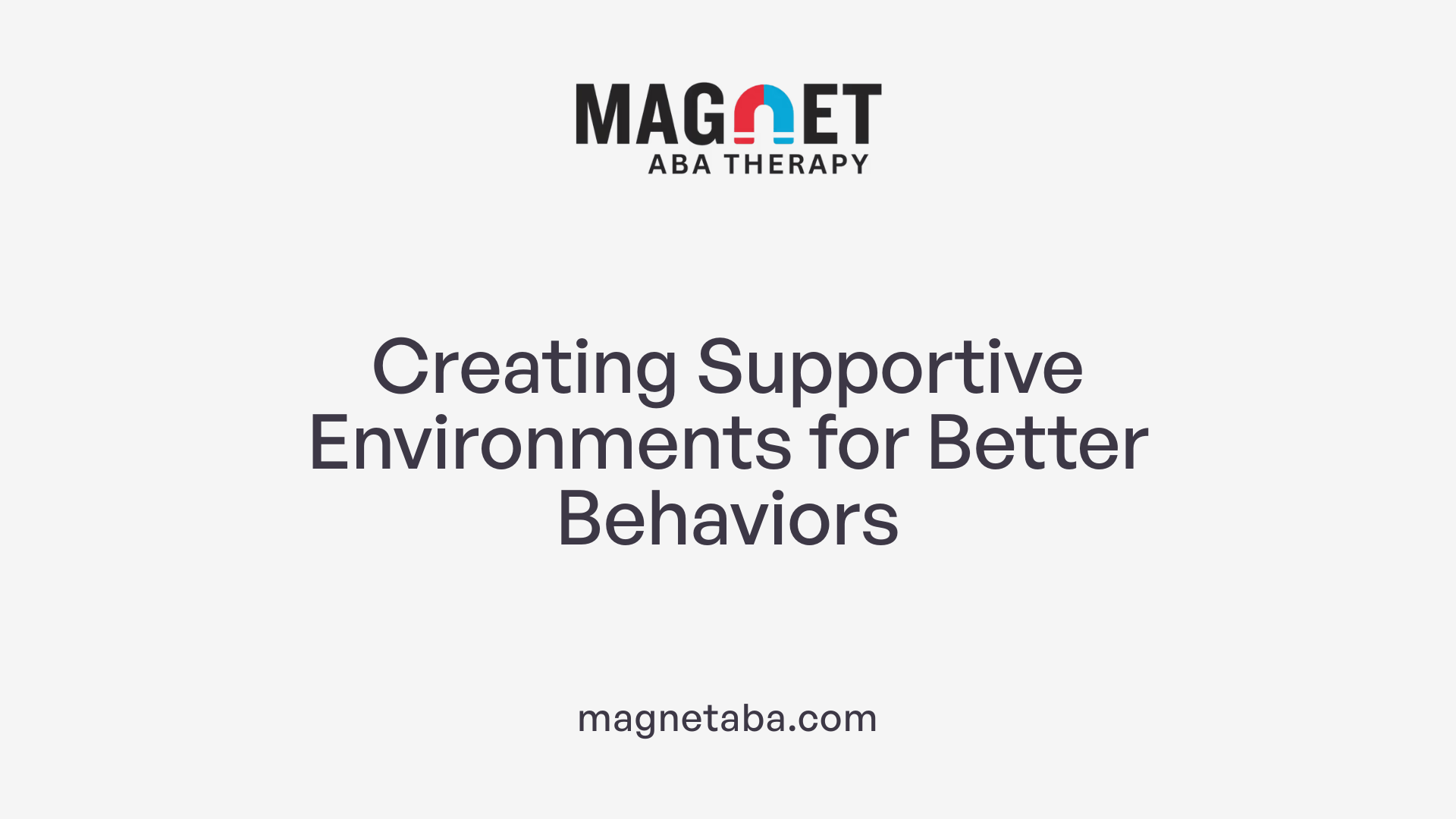Understanding the Foundations of Behavior Management
Behavior management is a critical component in supporting individuals with autism spectrum disorder (ASD) and other developmental challenges. Among various therapeutic approaches, antecedent-based interventions (ABIs) stand out as proactive strategies that help prevent undesirable behaviors before they occur. Rooted in the principles of Applied Behavior Analysis (ABA), these strategies modify the environment and leverage a thorough understanding of behavioral triggers to foster positive development. This article explores the pivotal role of antecedent strategies in managing behavior effectively, highlighting their implementation, benefits, and supporting evidence.
The Science Behind Antecedent Strategies
What are Antecedent-Based Interventions (ABIs)?
Antecedent-Based Interventions, or ABIs, are strategies focused on changing the environment before a behavior happens to reduce undesirable actions. Especially useful for learners with autism spectrum disorder (ASD) and other developmental disorders, these interventions aim to prevent challenging behaviors by tweaking what happens right before such behaviors occur.
How Does the ABC Model Explain Behavior?
At the heart of behavior analysis lies the ABC model—Antecedent, Behavior, Consequence. This framework helps understand how behaviors develop. The antecedent is the trigger or event that happens immediately before a behavior, the behavior is the action itself, and the consequence is what follows the behavior. By identifying and modifying the antecedent, educators and therapists can effectively influence behaviors without necessarily waiting to respond after the fact.
What Role Do Antecedents Play in Triggering Behavior?
Antecedents act as environmental or situational cues that can prompt a behavior. Common antecedents include noise levels, visual stimuli, changes in routine, social demands, and specific instructions from adults. Many challenging behaviors arise because these antecedents cause confusion, stress, or discomfort in learners. By modifying these triggers—such as reducing distractions, clarifying expectations with visual supports, or providing advanced notice of changes—undesirable behaviors can be minimized before they start.
ABIs rely on understanding these triggers and adjusting the environment accordingly to reduce behavioral challenges and promote more positive outcomes for learners with ASD and related developmental disorders.
Implementing Antecedent-Based Interventions in Autism Therapy

What is Functional Behavior Assessment?
Functional Behavior Assessment (FBA) is an essential first step when implementing antecedent-based interventions (ABIs). It involves systematically identifying the environmental factors that reinforce undesirable behaviors in learners with autism spectrum disorder (ASD). By understanding these factors, therapists and educators can modify the environment to prevent challenging behaviors before they occur.
How Are Environmental Triggers Identified?
During an FBA, the ABCs of behavior are carefully analyzed: Antecedent (what happens before the behavior), Behavior itself, and Consequence (what happens after). By focusing on the antecedents, professionals uncover specific triggers such as noise, visual distractions, or sudden routine changes that may lead to problem behaviors.
What Common Antecedent Factors Affect Behavior?
Several environmental elements frequently act as antecedents for challenging behaviors:
- Noise levels that overwhelm the learner
- Visual stimuli that may distract or confuse
- Unexpected changes to schedules or routines
- Social expectations and demands placed on students
How Can Antecedents Be Modified to Prevent Problem Behavior?
Modifying antecedents involves strategic changes, including:
- Adjusting the physical environment by reducing distractions and controlling lighting and noise
- Structuring classrooms with clear routines and visual markings
- Offering student choices to increase engagement
- Using visual supports to clarify expectations
- Preparing students for transitions with consistent cues
- Employing strategies such as behavior momentum, where easier tasks precede difficult ones, and noncontingent reinforcement to provide frequent attention independent of behavior
Together, these approaches create environments that support positive behaviors and reduce the likelihood of challenging behaviors emerging.
Common Antecedent Strategies and Techniques
Stimulus fading (Graduated Exposure)
Stimulus fading gradually introduces learners to challenging or anxiety-provoking situations by slowly increasing exposure to the stimuli. This method has proven highly effective, reducing challenging behaviors during medical procedures or unfamiliar tasks. About 96% of studies report positive outcomes, reflecting its success in easing transitions.
Noncontingent Reinforcement
This strategy involves delivering attention or preferred stimuli at fixed intervals, independent of the learner's behavior. By providing frequent, brief reinforcement, it reduces the motivation for undesirable behaviors, helping maintain engagement and focus.
Advanced Notice and Choice-Making
Alerting learners ahead of time about upcoming activities or schedule changes decreases anxiety and resistance. Offering choices empowers students and increases their compliance and engagement by giving them control over certain aspects of their experience.
Demand Fading and Behavior Momentum
Demand fading gradually lowers the number or difficulty of demands placed on learners to decrease challenging behaviors. Complementing this, behavior momentum starts sessions with easier tasks, building confidence and increasing the likelihood of completing more difficult demands.
Adjusting Environments, Routines, and Instructional Methods
Modifying the physical environment by minimizing distractions, managing noise and lighting, and structuring classrooms with clear expectations and visual cues reduces triggers for challenging behavior. Changing schedules, embedding visual supports, and adapting instruction styles to individual preferences further support positive behavior and increase engagement.
These antecedent-based strategies are often integrated into ABA programs by behavior analysts to tailor interventions and improve outcomes for learners with autism and related disorders.
Antecedent Strategies Within Applied Behavior Analysis (ABA)
What Are ABA Therapy Principles?
Applied Behavior Analysis (ABA) is a science-based therapy aimed at helping individuals with autism and related developmental disorders. ABA focuses on increasing helpful behaviors such as communication, social skills, and academic abilities while decreasing behaviors that might be harmful or unhelpful. Central to ABA is the ABC model—Antecedent, Behavior, Consequence—used to understand what triggers behaviors and how to modify them.
How Does ABA Emphasize Individualized Behavior Plans?
An essential feature of ABA is its flexibility and customization. Qualified behavior analysts, called BCBAs, assess each individual's skills and preferences to develop specific, measurable goals tailored to the learner. These goals are broken down into small, manageable steps, covering areas like social skills, self-care, and play. Progress is closely monitored with data collection, enabling adjustments that fit the learner's needs.
How Are Antecedent Strategies Integrated With Reinforcement and Other Methods?
Antecedent strategies in ABA focus on modifying the environment or situations that come before a behavior to prevent challenging behaviors and encourage positive ones. Examples include providing choice, giving advanced notice of changes, or fading demands gradually. These strategies are often combined with reinforcement techniques, such as positive reinforcement, which rewards desired behaviors to increase their occurrence. This integrated approach helps create a supportive learning environment that promotes engagement and decreases behavioral challenges.
What Roles Do BCBAs and Therapy Technicians Play?
BCBAs design and oversee individualized ABA programs, making decisions based on assessment and ongoing data. Therapy technicians, such as Registered Behavior Technicians (RBTs), implement the plans during sessions, working directly with the learner. The collaboration between these professionals ensures that antecedent strategies and reinforcement methods are applied effectively and consistently to support the learner's development.
Evidence Supporting Antecedent-Based Interventions
What does research say about antecedent-based interventions?
Numerous studies, including meta-analyses and systematic reviews, provide strong evidence that antecedent-based interventions (ABIs) effectively reduce challenging behaviors and improve compliance in individuals with autism spectrum disorder (ASD).
How effective are ABIs in behavior management?
Research shows that antecedent-only interventions successfully decrease challenging behaviors in about 67.5% of cases studied. These strategies target environmental triggers before behaviors occur, making them a proactive way to support learners.
Are there specific intervention techniques backed by evidence?
Yes. Stimulus fading, also known as graduated exposure, is highly effective for reducing challenging behaviors, especially during medical procedures. A systematic review found that 96% of studies reported positive outcomes using this technique. Demand fading and giving advanced notice to learners before changes or demands are introduced have also shown high effectiveness.
Does a recognized authority endorse ABIs?
The National Clearinghouse on Autism Evidence and Practice (NCAEP) recognizes antecedent-based interventions as evidence-based practices. This endorsement reflects consensus among experts about their value in autism support plans.
Together, these findings underscore that ABIs are a validated and valuable component of behavior intervention programs. Ongoing research continues to optimize how best to implement these techniques for individual learners.
Environmental Modifications to Minimize Challenging Behaviors

Adjusting Physical Environment (Noise, Lighting, Distractions)
One effective way to reduce challenging behaviors in learners with autism spectrum disorder is by carefully modifying their physical surroundings. Lowering noise levels and controlling lighting can reduce sensory overload, which often triggers undesirable behaviors. Minimizing distractions by removing clutter or irrelevant stimuli helps learners remain focused and calm.
Structuring Classrooms and Therapy Settings
Organizing the learning space with clear expectations and routines supports behavioral regulation. Using visual markers and designated areas guides learners on what to expect and how to behave. A well-structured environment reduces uncertainty and anxiety, leading to fewer challenging incidents.
Use of Visual Supports and Clear Routines
Visual supports such as schedules, charts, and cue cards convey information clearly and reduce confusion. Establishing predictable routines helps learners understand what comes next, which fosters engagement and compliance. These tools are especially helpful for students who struggle with verbal instructions or changes in activity.
Preparing for Transitions and Changes
Transitions can be challenging for individuals with ASD. Providing consistent cues and advanced notice before a change helps prepare learners mentally. Techniques like visual timers or countdowns offer clear signals, making transitions smoother and minimizing behavior disruptions.
By implementing these environmental modifications thoughtfully, educators and therapists create settings that promote positive behaviors and reduce challenging episodes effectively.
The Role of Individualization and Professional Guidance

Importance of Individualized Behavior Plans
Individualized behavior plans are essential for effectively supporting learners with autism spectrum disorder (ASD) and other developmental disorders. These plans are tailored to each student's unique needs, preferences, and skill levels. By customizing interventions, educators can address specific antecedents that trigger challenging behaviors while promoting positive behavior change. Individualized plans improve engagement and ensure that interventions are relevant and meaningful to the learner.
Consultation with BCBAs
Consulting with Board Certified Behavior Analysts (BCBAs) is crucial when implementing antecedent-based interventions (ABIs). BCBAs are trained professionals who design, oversee, and modify behavior plans based on ongoing assessments. Their expertise ensures that strategies align with best practices in Applied Behavior Analysis (ABA) and remain evidence-based. Collaborating with BCBAs helps educators and caregivers implement interventions safely and effectively, increasing the likelihood of positive outcomes.
Tailoring Strategies to Student Preferences and Needs
Effective antecedent strategies rely heavily on understanding student preferences and environmental factors. This includes offering choices, using visual supports, and adapting routines to reduce confusion. Tailoring methods such as behavior momentum—where easier tasks precede more challenging ones—or noncontingent reinforcement according to the learner’s interests can enhance motivation and reduce problem behaviors.
Ensuring Safe and Effective Implementation
Safe and effective implementation requires careful planning and adherence to individualized behavior plans. This involves setting clear expectations, providing consistent cues for transitions, and monitoring the student's responses. Working within a well-structured framework minimizes risks and promotes positive experiences. Ongoing data collection and supervisor oversight guarantee that the interventions remain appropriate and adjust as necessary for continuous improvement.
Benefits and Challenges of Using Antecedent Strategies

What Are the Advantages of Proactive Behavior Management?
Antecedent-based interventions (ABIs) offer proactive solutions by modifying environmental triggers before challenging behaviors occur. This preemptive approach helps learners with autism spectrum disorder (ASD) engage more positively and reduces the need to respond reactively to behaviors.
How Do Antecedent Strategies Reduce Challenging Behaviors?
Research shows that ABIs effectively reduce both the frequency and intensity of problematic behaviors. Techniques like stimulus fading, demand fading, and providing advanced notice prepare students for upcoming changes, making transitions smoother and enhancing compliance. For example, systematic reviews report that stimulus fading achieves positive outcomes in 96% of medical procedure cases.
What Challenges Exist in Implementing These Strategies?
Implementing ABIs requires ongoing assessment, often beginning with a functional behavior assessment to identify environmental factors triggering behaviors. Challenges include accurately pinpointing antecedents and modifying them suitably, which demands expertise and continuous monitoring to ensure effectiveness.
Why Combine Antecedent Strategies with Consequences and Reinforcement?
While antecedent strategies reduce the likelihood of challenging behaviors, they are most effective when combined with consequential strategies such as positive reinforcement. This combined approach encourages skill acquisition and supports behavior maintenance, aligning with the broader principles of applied behavior analysis (ABA).
| Aspect | Benefit/Challenge | Specific Example or Detail |
|---|---|---|
| Proactive Management | Decreases occurrence of undesirable behaviors | Adjusting routines or providing choices |
| Behavior Reduction | Lowers frequency and severity of challenging behaviors | Stimulus fading during medical procedures |
| Implementation Complexity | Requires functional behavior assessment and monitoring | Continuous data collection and collaboration with BCBA |
| Combined Interventions | ABA integrates antecedent with reinforcement techniques | Positive reinforcement increases desired behaviors |
These insights underscore the value of antecedent strategies as part of a comprehensive plan to support learners with ASD while highlighting the importance of professional guidance and adaptive approaches.
Future Directions and Research Needs in Antecedent Strategy Use

Emerging Comprehensive Packages of Antecedent Interventions
Recent studies have begun to evaluate comprehensive packages that combine multiple antecedent strategies to address challenging behaviors more effectively. These packages include methods like stimulus fading, demand fading, choice-making, and advanced notice, tailored to individual needs within varied settings. Early results have shown promising reductions in challenging behaviors, pointing to the benefit of integrating several environmental modifications simultaneously.
Need for Further Research on Optimal Implementation
While antecedent-based interventions (ABIs) on their own have demonstrated meaningful success—reducing challenging behaviors in about two-thirds of applications—research still lacks clarity on the most effective ways to implement these strategies in diverse contexts. Further studies are necessary to determine optimal protocols, such as which combination of strategies yields the best outcomes for different types of behaviors and individual profiles.
Potential for Broader Application in Various Settings
Though much research has focused on school and clinical environments, there is growing interest in expanding antecedent strategies to other settings like homes, community programs, and workplaces. This expansion could support individuals with ASD and related disorders in more naturalistic environments, thus promoting generalization and maintenance of positive behaviors across multiple contexts.
Integration with Technological Tools and Data Monitoring
Future directions also include leveraging technology to enhance antecedent strategy implementation. Tools such as digital scheduling aids, wearable devices to monitor physiological responses, and software for real-time data collection can help caregivers and professionals adjust interventions promptly. Integrating technology can promote individualized support and ongoing assessment, which are crucial for the dynamic nature of behavior management.
Overall, advancing antecedent-based interventions through comprehensive packages, rigorous research, broad applicability, and technological support holds significant promise for improving behavior outcomes in individuals with developmental disorders.
Conclusion: Antecedent Strategies as a Cornerstone of Effective Behavior Management
Antecedent-based interventions represent a fundamental approach to behavior management within therapies for autism and developmental disorders. By focusing on modifying triggers and environmental factors before challenging behaviors arise, these strategies empower practitioners to create environments more conducive to learning and positive behavior. Supported by robust scientific evidence and integrated deeply into Applied Behavior Analysis, antecedent strategies offer a proactive pathway to improvements in communication, social skills, and daily functioning. Ongoing research and individualized application will continue to refine these methods, ensuring that individuals with ASD receive the most effective, compassionate support tailored to their unique needs.












